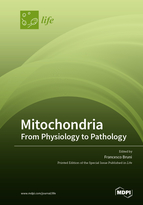Mitochondria: From Physiology to Pathology
A special issue of Life (ISSN 2075-1729). This special issue belongs to the section "Physiology and Pathology".
Deadline for manuscript submissions: closed (30 April 2021) | Viewed by 38656
Special Issue Editor
Interests: mitochondria; mitochondrial biogenesis; mtDNA gene expression; mitoribosome
Special Issues, Collections and Topics in MDPI journals
Special Issue Information
Dear Colleagues
Mitochondria play an increasingly central role in the context of cellular physiology. These organelles possess their own DNA (mtDNA), functionally coordinated with nuclear genome; mitochondrial gene expression is mediated by molecular processes (replication, transcription, translation, and assembly of respiratory chain complexes) that all take place within the mitochondria. Several aspects of mtDNA expression have already been well-characterized, but many more either are still under debate or have yet to be discovered.
Understanding the molecular processes occurring in mitochondria also has a clinical relevance. Dysfunctions affecting these important metabolic ‘hubs’ are associated to a whole range of severe disorders, best known as mitochondrial diseases. In recent years, significant progress has been made to understand the pathogenic mechanisms underlying mitochondrial dysfunction, also thanks to the rapid development of next-generation sequencing technologies. To date, mitochondrial diseases are complex genetic disorders without any effective therapy. Current therapeutic strategies and clinical trials are aimed at mitigating clinical manifestations and slowing the disease progression in order to improve the lifestyle of patients.
The goal of this Special Issue is to collect research and review articles covering the physiological and pathological aspects related to mtDNA maintenance and gene expression, mitochondrial biogenesis and protein import, organelle metabolism and quality control, as well as mitochondrial diseases.
Prof. Francesco Bruni
Guest Editor
Manuscript Submission Information
Manuscripts should be submitted online at www.mdpi.com by registering and logging in to this website. Once you are registered, click here to go to the submission form. Manuscripts can be submitted until the deadline. All submissions that pass pre-check are peer-reviewed. Accepted papers will be published continuously in the journal (as soon as accepted) and will be listed together on the special issue website. Research articles, review articles as well as short communications are invited. For planned papers, a title and short abstract (about 100 words) can be sent to the Editorial Office for announcement on this website.
Submitted manuscripts should not have been published previously, nor be under consideration for publication elsewhere (except conference proceedings papers). All manuscripts are thoroughly refereed through a single-blind peer-review process. A guide for authors and other relevant information for submission of manuscripts is available on the Instructions for Authors page. Life is an international peer-reviewed open access monthly journal published by MDPI.
Please visit the Instructions for Authors page before submitting a manuscript. The Article Processing Charge (APC) for publication in this open access journal is 2600 CHF (Swiss Francs). Submitted papers should be well formatted and use good English. Authors may use MDPI's English editing service prior to publication or during author revisions.
Keywords
- Mitochondrial biogenesis
- Mitochondrial disease
- mtDNA gene expression
- Mitochondrial genome maintenance
- Mitochondrial transcription
- mtRNA turnover
- Mitochondrial translation
- Organelle metabolism
- Mitochondriopathies







